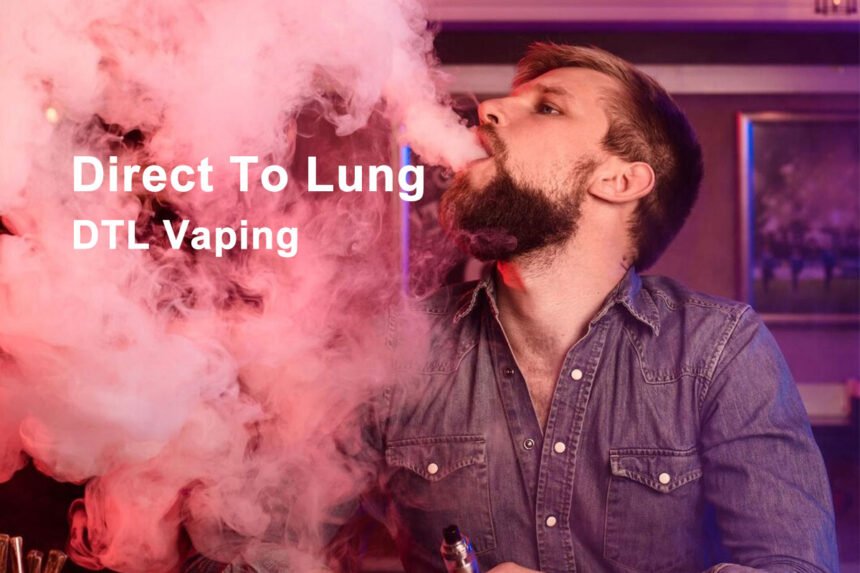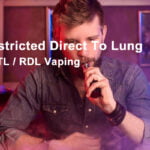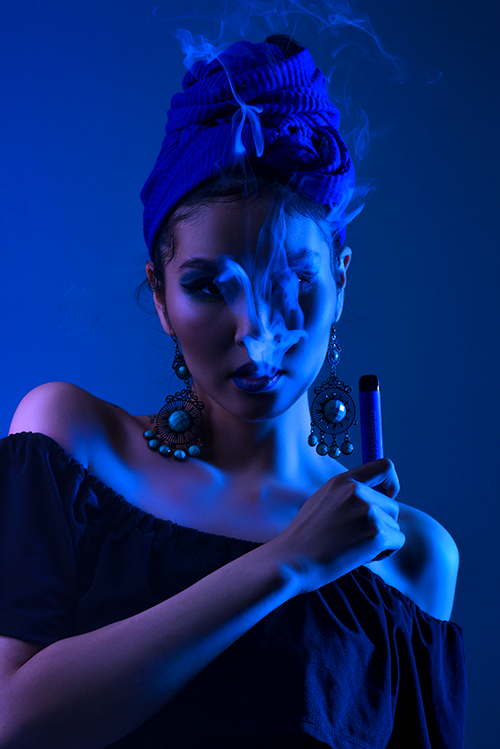- MTL – ’Mouth To Lung’
- DTL – ‘Direct To Lung’ (Sometimes referred to as ‘Straight to Lung’ or ‘Direct Lung’)
- RDTL / RDL – ‘Restricted Direct To Lung’ – Between MTL vaping and DTL vaping
Vaping has become a popular alternative to traditional smoking, offering users a range of experiences and customization options. Among the various styles of vaping, Direct To Lung (DTL) vaping stands out for its distinct method of inhalation, which involves drawing vapor directly into the lungs. This method contrasts sharply with Mouth To Lung (MTL) vaping, where the vapor is first held in the mouth before being inhaled into the lungs. This article aims to provide a comprehensive guide to DTL vaping, covering its techniques, benefits, recommended nicotine strengths, PG/VG ratios, coil resistances, and airflow settings.
Understanding DTL Vaping
The Technique
Direct To Lung vaping involves a specific inhalation technique that requires some adaptation for those new to this style. Here are the steps to master DTL vaping:
- Draw Slow and Steady: Inhale slowly and steadily directly into your lungs for about 3 to 5 seconds. Avoid sharp, quick puffs as they can be harsh on the throat and lungs.
- Direct Inhalation: Unlike MTL vaping, where you hold the vapor in your mouth, DTL vaping sends the vapor directly into your lungs, akin to taking a deep breath.
- Exhale Clouds: Once the vapor reaches your lungs, exhale large clouds of vapor, often resulting in a more satisfying and visually impressive experience.
Why Vape DTL?
DTL vaping can be initially shocking to the lungs, but with gradual adaptation, it becomes a preferred method for many. Starting with low wattage and tight airflow, and gradually increasing them, helps the lungs adjust. The sensation of drawing large amounts of vapor directly into the lungs can be compared to controlling weather, evoking a sense of power and enjoyment. This method also allows for sampling a wider range of flavors and produces impressive vapor clouds, which can be a source of joy and entertainment.
Nicotine, PG, and VG for DTL Vaping
Nicotine Strength
For DTL vaping, lower nicotine strengths are recommended due to the larger volume of vapor inhaled. Higher nicotine levels can result in a harsh throat hit and an overwhelming nicotine rush. The general recommendations are:
- 3mg: The most common choice for DTL vapers, providing a smooth experience with minimal throat hit.
- 6mg or less: Suitable for those who prefer a slightly stronger nicotine presence but still want to avoid harshness.
PG/VG Ratio
The PG (Propylene Glycol) and VG (Vegetable Glycerin) ratios in e-liquids significantly impact the vaping experience. DTL vaping typically favors higher VG ratios for smoother and denser vapor production. Here are some recommended ratios:
- 60VG/40PG: Offers good flavor, decent cloud production, and a slight throat hit.
- 70VG/30PG: Popular among sub-ohm vapers, providing good flavor, ample clouds, and a smooth throat hit.
- 80VG/20PG: Produces dense clouds with a smooth throat hit, suitable for those who prioritize vapor production.
- 90VG/10PG: Even denser clouds and smoother on the throat, ideal for cloud chasers.
- 100% VG: Pure cloud production and very smooth, often used by vapers sensitive to PG.
Tanks and Wicking High VG Juices
High VG juices have a thicker viscosity, which can challenge some tanks’ wicking capabilities. Not all sub-ohm tanks can efficiently wick high VG juices, potentially leading to dry hits during chain vaping. To avoid this, ensure your tank is designed to handle high VG juices or start with a 70VG/30PG ratio to be safe.
Coil Resistance for DTL Vaping
Understanding Coil Resistance
Coil resistance is crucial in DTL vaping, affecting the power and heat generated during use. Lower resistance coils, known as sub-ohm coils (below 1.0 ohm), are essential for DTL vaping. These coils allow for higher wattage and more vapor production. Here are some key points:
- Lower Resistance (DTL/Sub-ohm): Coils below 1.0 ohm, typically ranging from 0.1 to 0.9 ohm. The most common resistances are 0.3 ohm to 0.6 ohm.
- Higher Resistance (MTL): Coils above 1.0 ohm, suitable for MTL vaping.
Benefits of Lower Resistance Coils
- Higher Wattage: Allows for more power to be fed to the coil, resulting in more vapor production.
- Thicker Wires: Lower resistance coils use thicker wires, which can sustain higher temperatures for longer periods without damage.
- Cloud Production: Essential for achieving the large vapor clouds associated with DTL vaping.
Airflow Settings
Airflow plays a significant role in the DTL vaping experience. Most tanks allow for adjustable airflow, which can be fine-tuned to suit your preferences:
- Open Airflow: Allows more air to flow through the tank, resulting in longer, easier hits and increased cloud production.
- Closed Airflow: Provides a more intense, warmer vape with a slightly restricted draw, enhancing flavor.
Experimenting with airflow settings helps find the perfect balance between flavor and vapor production. For those who prefer a smoother vape, medium airflow settings are recommended to prevent the vapor from becoming too hot.
Advantages of DTL Vaping
Enhanced Flavor and Vapor Production
DTL vaping excels in both flavor intensity and vapor production. The direct inhalation method allows for a more pronounced flavor experience, while the higher wattage and lower resistance coils produce dense vapor clouds. This combination makes DTL vaping appealing to those who prioritize taste and visual appeal.
Customization and Flexibility
DTL vaping offers extensive customization options, from adjusting wattage and airflow to selecting different coil resistances and e-liquid ratios. This flexibility allows users to tailor their vaping experience to their preferences, making DTL vaping highly versatile.
Smoother Experience
With the right PG/VG ratio and nicotine strength, DTL vaping provides a smoother inhale compared to traditional smoking and even some MTL vaping setups. Higher VG ratios contribute to a silkier vapor, reducing the harshness on the throat.
Social and Visual Appeal
The ability to produce large, impressive vapor clouds makes DTL vaping a social activity, often shared among friends and showcased on social media platforms. The visual appeal of vapor clouds adds an element of fun and creativity to the vaping experience.
Challenges and Considerations
Initial Adjustment Period
For those new to DTL vaping, the initial adjustment period can be challenging. The direct inhalation method might feel overwhelming at first, but gradually increasing wattage and airflow can help ease the transition.
Equipment Compatibility
Not all vaping devices and tanks are suitable for DTL vaping. Ensuring compatibility with sub-ohm coils and high VG juices is essential to avoid dry hits and other issues. Researching and selecting the right equipment is crucial for a satisfying DTL experience.
Nicotine Sensitivity
Lower nicotine strengths are recommended for DTL vaping due to the larger vapor volume inhaled. Users accustomed to higher nicotine levels might need to adjust their preferences to avoid harsh throat hits and nicotine overload.
Conclusion
Direct To Lung vaping offers a unique and enjoyable experience for those willing to explore its techniques and benefits. By understanding the optimal nicotine strengths, PG/VG ratios, coil resistances, and airflow settings, vapers can customize their DTL experience to their liking. While there is an initial adjustment period, the enhanced flavor, vapor production, and social appeal make DTL vaping a popular choice among enthusiasts. Whether you’re a seasoned vaper or new to the world of vaping, DTL vaping provides a versatile and satisfying alternative to traditional smoking.











